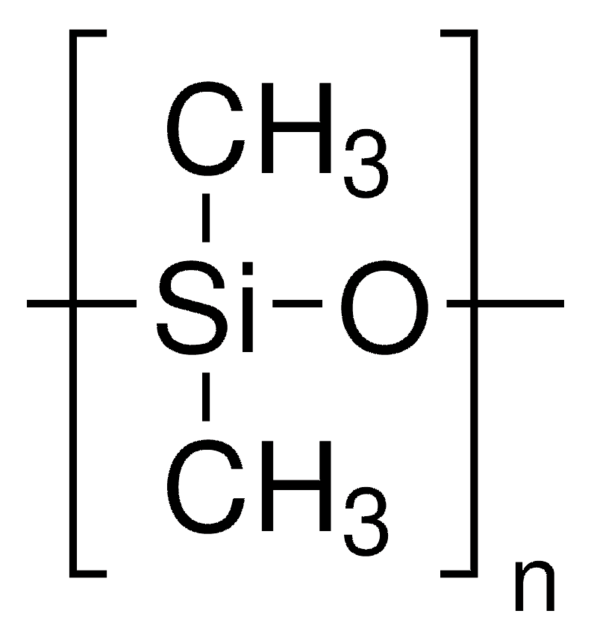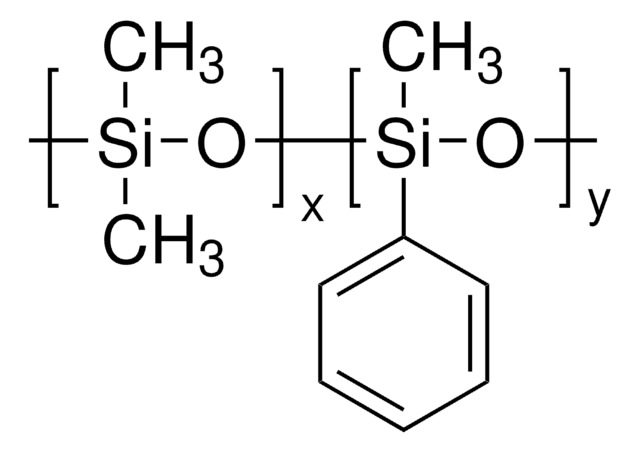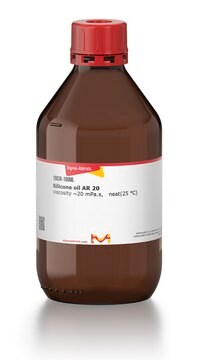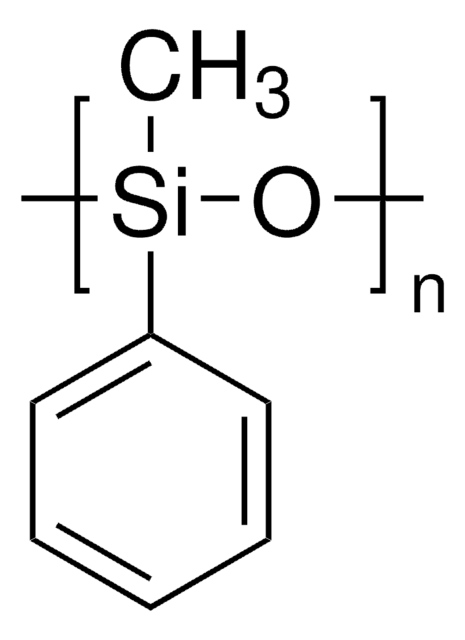378321
Silicone oil
viscosity 10 cSt (25 °C)
Sinonimo/i:
PDMS, Polydimethylsiloxane
Autenticatiper visualizzare i prezzi riservati alla tua organizzazione & contrattuali
About This Item
Formula condensata:
[-Si(CH3)2O-]n
Numero CAS:
Numero MDL:
Codice UNSPSC:
12162002
NACRES:
NA.23
Prodotti consigliati
Densità del vapore
>1 (vs air)
Livello qualitativo
Tensione di vapore
<5 mmHg ( 25 °C)
5 mmHg ( 20 °C)
Stato
liquid
Indice di rifrazione
n20/D 1.403 (lit.)
Viscosità
10 cSt(25 °C)
P. ebollizione
>140 °C/0.002 mmHg (lit.)
Densità
0.93 g/mL at 25 °C
Cerchi prodotti simili? Visita Guida al confronto tra prodotti
Categorie correlate
Descrizione generale
Silicon oils constitute a group of hydrophobicpolymeric compounds with a linear chain of siloxanerepeating units (–Si–O) and a variety of side chains. Owing to their uniqueproperties like wettability, lubrication, smooth gliding behavior, andmechanical strength, they are widely used in electric insulators, anti-foaming,laboratories, and lubricants.
Silicone oil is a low viscosity, liquid polymerized, siloxane with organic side chains. Silicone oil exhibits antimicrobial activity against endopthalmitis causing microorganisms under in vitro conditions.
Applicazioni
Silicone oilcan be used as an intraocular liquid in vitreoretinal surgery as it canmaintain the adhesion between the retina and retinal pigment epithelium.
It can be used in a two-phase partitioning bioreactor totreat gas effluents. Silicon oils are compatible with the aqueous phase andlead to better emulsion between the two phases.
Itcan also be used to generate hydrophobic coatings on glass surfaces.(4)
It can be used in a two-phase partitioning bioreactor totreat gas effluents. Silicon oils are compatible with the aqueous phase andlead to better emulsion between the two phases.
Itcan also be used to generate hydrophobic coatings on glass surfaces.(4)
Caratteristiche e vantaggi
- High spreading power
- Non-toxic
- High lubricity
- Formation of stable film strips
- Goodstability
Codice della classe di stoccaggio
10 - Combustible liquids
Classe di pericolosità dell'acqua (WGK)
WGK 1
Punto d’infiammabilità (°F)
214.0 °F - closed cup
Punto d’infiammabilità (°C)
101.1 °C - closed cup
Dispositivi di protezione individuale
Eyeshields, Gloves
Scegli una delle versioni più recenti:
Possiedi già questo prodotto?
I documenti relativi ai prodotti acquistati recentemente sono disponibili nell’Archivio dei documenti.
I clienti hanno visto anche
Maurizio Mete et al.
Graefe's archive for clinical and experimental ophthalmology = Albrecht von Graefes Archiv fur klinische und experimentelle Ophthalmologie, 249(6), 821-826 (2010-11-17)
Several surgical techniques have been described for the treatment of retinal detachment (RD) associated to myopic macular hole (MMH). In this retrospective study, the anatomical and functional outcomes of pars plana vitrectomy (PPV) with long-term tamponade, using either 1000 cSt
Daniel Bar-David et al.
Optics express, 26(15), 19115-19122 (2018-08-17)
We experimentally demonstrate light-flow interaction, in which the angular momentum of circulating light excites micro-vortices. In contrast with the solid-phase of matter, where one has to overcome static friction in order to start motion, liquids have no "static drag." Relevant
Jean-Marc Aldric et al.
Applied biochemistry and biotechnology, 153(1-3), 67-79 (2009-01-22)
A two-phase partitioning bioreactor to treat gas effluents polluted by volatile organic compound has been developed. In this work, both the mass transfer of isopropylbenzene (IPB) and oxygen have been considered in relation to their influence on the hydrodynamics of
Tindaro Ioppolo et al.
Journal of visualized experiments : JoVE, (71)(71), e50199-e50199 (2013-02-15)
Optical modes of dielectric micro-cavities have received significant attention in recent years for their potential in a broad range of applications. The optical modes are frequently referred to as "whispering gallery modes" (WGM) or "morphology dependent resonances" (MDR) and exhibit
Benjamin R Schudel et al.
Lab on a chip, 13(5), 811-817 (2013-01-31)
RNA interference (RNAi) is a powerful tool for functional genomics with the capacity to comprehensively analyze host-pathogen interactions. High-throughput RNAi screening is used to systematically perturb cellular pathways and discover therapeutic targets, but the method can be tedious and requires
Global Trade Item Number
| SKU | GTIN |
|---|---|
| 378321-1L | 4061831835977 |
| 378321-250ML | 4061831835984 |
| 378321-5ML |
Il team dei nostri ricercatori vanta grande esperienza in tutte le aree della ricerca quali Life Science, scienza dei materiali, sintesi chimica, cromatografia, discipline analitiche, ecc..
Contatta l'Assistenza Tecnica.



